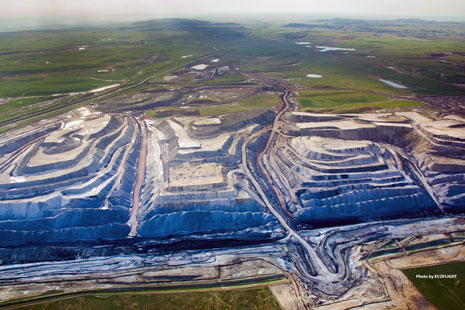Market forces have battered the coal industry for years. When the country’s three largest coal mining companies entered bankruptcy over the past 18 months, no one was sure they would emerge. WORC leaders and staff engaged in all three bankruptcy cases to prevent the public purse from paying for the clean-up of massive western strip mines with taxpayer money. With the emergence of Peabody Energy from bankruptcy in early April, we’re celebrating a major victory!
Here’s how it started
The gusher of coal bankruptcies began around 2012, with the bankruptcy filings of 50 smaller companies mostly based in Appalachia. During the eight months between August 2015 and April 2016, Alpha Natural Resources, Arch Coal, and Peabody filed for bankruptcy. In 2015, those three companies produced about 40% of the coal mined across the country.
Coal-fired electricity has become more expensive than power produced from natural gas and renewable sources. With competition eroding coal’s market, the coal companies sought to “reorganize” their businesses by slashing debts and restructuring contracts under the sweeping protection of bankruptcy law. Bankruptcy forces a reckoning regarding the valuation of a company’s assets, however. If a company has insufficiently valuable assets, it can’t reorganize and must liquidate its business to pay debts.
For more information on our work on coal issues, visit our Coal page.
This posed a big threat to the clean-up, or “reclamation,” of many mining operations, because the three companies had not put up any guarantee for the reclamation. Instead, Alpha, Arch, and Peabody posted “self-bonds” for the majority of their reclamation obligations. A self-bond is an unenforceable “IOU” for companies that are considered “too big to fail.” If a coal company meets certain financial tests, the company can promise to complete reclamation without turning over any funds to regulators.
We had to get involved
To protect the public interest in clean air, water, and reclaimed land, WORC and its member groups recognized the need to force the replacement of self-bonds through the bankruptcy process. That meant engaging in bankruptcy court.
Bob LeResche, Chair of Powder River Basin Resource Council, crystallized the urgency of the task:
“Bankruptcy should never be used as a haven for a huge corporation to escape its reclamation bonding obligations. Better financial assurance will protect taxpayers and neighboring landowners and will ensure that the mining company remains responsible for any clean-up costs.”
With bankruptcy counsel Jim Burghardt at Moye White LLP, WORC leaders and staff began figuring out how our community organizations could navigate bankruptcy court to protect the public’s interest in successful coal mine reclamation. Unlike most courts, the amount of money owed to you determines your heft and leverage. It was not clear that a bankruptcy judge would weigh our organizations’ interests at all.
There are several worst-case scenarios from a landowner perspective. First, companies could be unable to emerge from bankruptcy, resulting in liquidation of worthless self-bonds. Second, companies could evade their bonding and reclamation obligations with the blessing of a bankruptcy judge. Mine neighbors would be left with giant pits and the federal and state governments would be saddled with the cleanup bill. If the companies emerged from bankruptcy with self-bonds intact, they would face the same market conditions that undercut their business in the first place. Some coal companies have already filed for bankruptcy twice, and liquidated in round two. If that happened, mines could go unreclaimed notwithstanding now-worthless self-bonds.
That didn’t happen here. Orders from federal judges require Alpha, Arch, and Peabody to replace self-bonds after emerging from bankruptcy. The total amount of self-bonds replaced across the country by Alpha, Arch, and Peabody is approximately $2.4 billion. This is great news for neighboring landowners and the public purse.
What did we learn?
Like any campaign, WORC network staff and leaders recalled old lessons and learned new ones along the way. Here are a few:
- Success in bankruptcy court, like organizing, is all about relationships. The bankruptcy process is built on negotiation between parties: the debtors, banks, hedge funds, business counter-parties, representatives of various levels of government, and others. Many outcomes are possible in bankruptcy. Parties work out crucial details of the case in side conversations, including in the hallway before the monthly court hearing. You need legal representation to get to the table and a plan about who can give you what you need.
- The participation of WORC and its partners created uncertainty for the bankrupt companies. We put strong arguments before the bankruptcy judge that would not be made by any other party in the case, and they may have strengthened the hand of the federal government’s own arguments. Our aggressive posture caught the attention of company management. For example, a recent investor slide-deck from Peabody touts its replacement of self-bonds for reducing uncertainty for the company and protecting its social license to operate. We agree that any company whose business model contemplates dodging the costs of its own clean-up should not be operating. Instead of trying to squeak through with continued self-bonding, the companies replaced their self-bonds outright with real guarantees of mine clean-up.
- The surety bond industry ended up bailing us out. In Peabody’s case, surety companies lodged lower-than-expected bids to replace self-bonds. It’s possible that Peabody’s management intentionally inflated estimated costs to achieve self-bond replacement. It could be that the surety industry saw an opportunity for new business. It’s possible that the industry places misplaced confidence in the long-term market for coal. We likely won’t know, but our pressure on self-bonding helped create an opportunity for the companies to replace their self-bonds.
- When confronting a big problem, look for unusual opportunities. Bankruptcy is a period of remarkable transformation for a company. This makes it a major opportunity for community organizations looking to affect company policy and compliance with the law. We need to be aggressive about looking for new opportunities and venues to achieve our policy goals. That means remaining open to unconventional ideas like pursuing strategic objectives in unfamiliar venues such as bankruptcy court.
What’s Next?
Market pressure may send coal companies back to bankruptcy court sooner than they would like. Coal is subject to persistent pressures that restructuring can’t change. First, coal production has declined significantly since 2008. Second, coal-fired electricity is among the most expensive across many parts of the country. Third, capital markets are rushing headlong toward renewable energy. Despite these substantial headwinds, each of the bankrupt coal companies promised post-bankruptcy success. The companies relied on overly rosy projections that overstated the future prospects for the coal market. Despite the risk of a second bankruptcy, executives at Peabody assert their right to return to self-bonding after emerging from bankruptcy. Although we should savor the aversion of a mine cleanup catastrophe, the situation demands our continued vigilance.
For more information on our work on coal issues, visit our Coal page.
Sign up for WORC blogs
WORC will send you a notice of new blog posts. You can sign up here.
Read more coal stories here.
Read more:
Investigation of Ramaco Principals Reveals Shady History
Current State of Coal Industry and Mineral Tax Collection Creates a Tax Time-bomb
Unanimous Vote by Wyoming Environmental Quality Council Clears the Way for Strong Self-Bonding Rules


